Stakeholder Theory: Introduction, Annotated Bibliography, References
VerifiedAdded on 2021/02/20
|11
|2237
|57
Report
AI Summary
This report delves into the concept of stakeholder theory, examining its significance in business and organizational contexts. It begins with an introduction that defines stakeholders and their importance to a business's success. The core of the report is an annotated bibliography, which analyzes ten academic sources related to stakeholder theory, non-profit organizations, and social impact. Each entry provides a concise abstract summarizing the source's key arguments and findings. The sources cover various aspects, including performance measurement in non-profits, the impact of social media on stakeholder engagement, and the role of stakeholders in driving organizational sustainability. The report concludes by emphasizing the critical role of stakeholder theory in overall organizational development. The references section provides a complete list of the sources cited in the report, including books and journal articles.
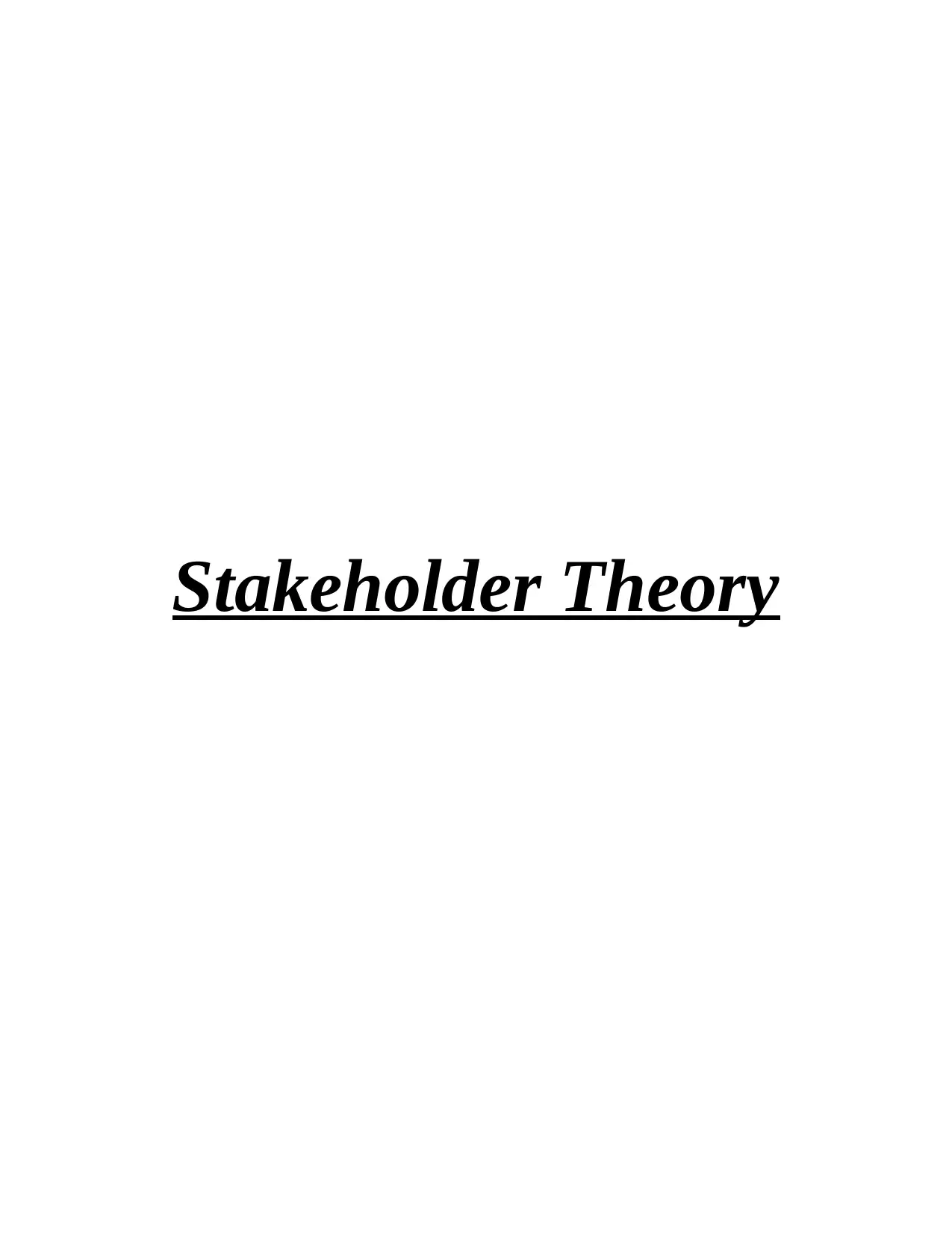
Stakeholder Theory
Paraphrase This Document
Need a fresh take? Get an instant paraphrase of this document with our AI Paraphraser

Table of Contents
INTRODUCTION...........................................................................................................................3
Annotated Bibliography...................................................................................................................4
CONCLUSION................................................................................................................................9
REFERENCES................................................................................................................................9
INTRODUCTION...........................................................................................................................3
Annotated Bibliography...................................................................................................................4
CONCLUSION................................................................................................................................9
REFERENCES................................................................................................................................9
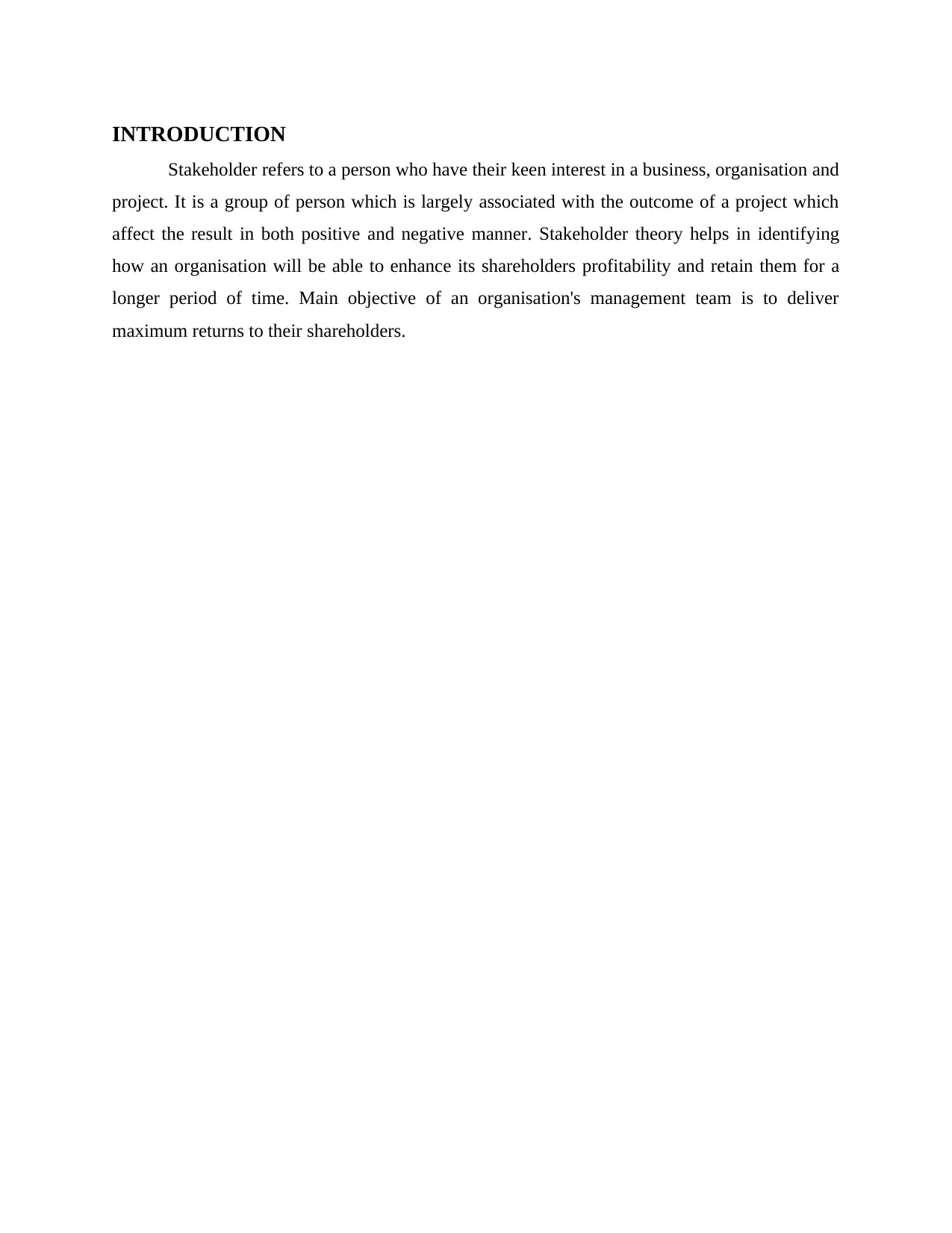
INTRODUCTION
Stakeholder refers to a person who have their keen interest in a business, organisation and
project. It is a group of person which is largely associated with the outcome of a project which
affect the result in both positive and negative manner. Stakeholder theory helps in identifying
how an organisation will be able to enhance its shareholders profitability and retain them for a
longer period of time. Main objective of an organisation's management team is to deliver
maximum returns to their shareholders.
Stakeholder refers to a person who have their keen interest in a business, organisation and
project. It is a group of person which is largely associated with the outcome of a project which
affect the result in both positive and negative manner. Stakeholder theory helps in identifying
how an organisation will be able to enhance its shareholders profitability and retain them for a
longer period of time. Main objective of an organisation's management team is to deliver
maximum returns to their shareholders.
⊘ This is a preview!⊘
Do you want full access?
Subscribe today to unlock all pages.

Trusted by 1+ million students worldwide

Annotated Bibliography
Paraphrase This Document
Need a fresh take? Get an instant paraphrase of this document with our AI Paraphraser
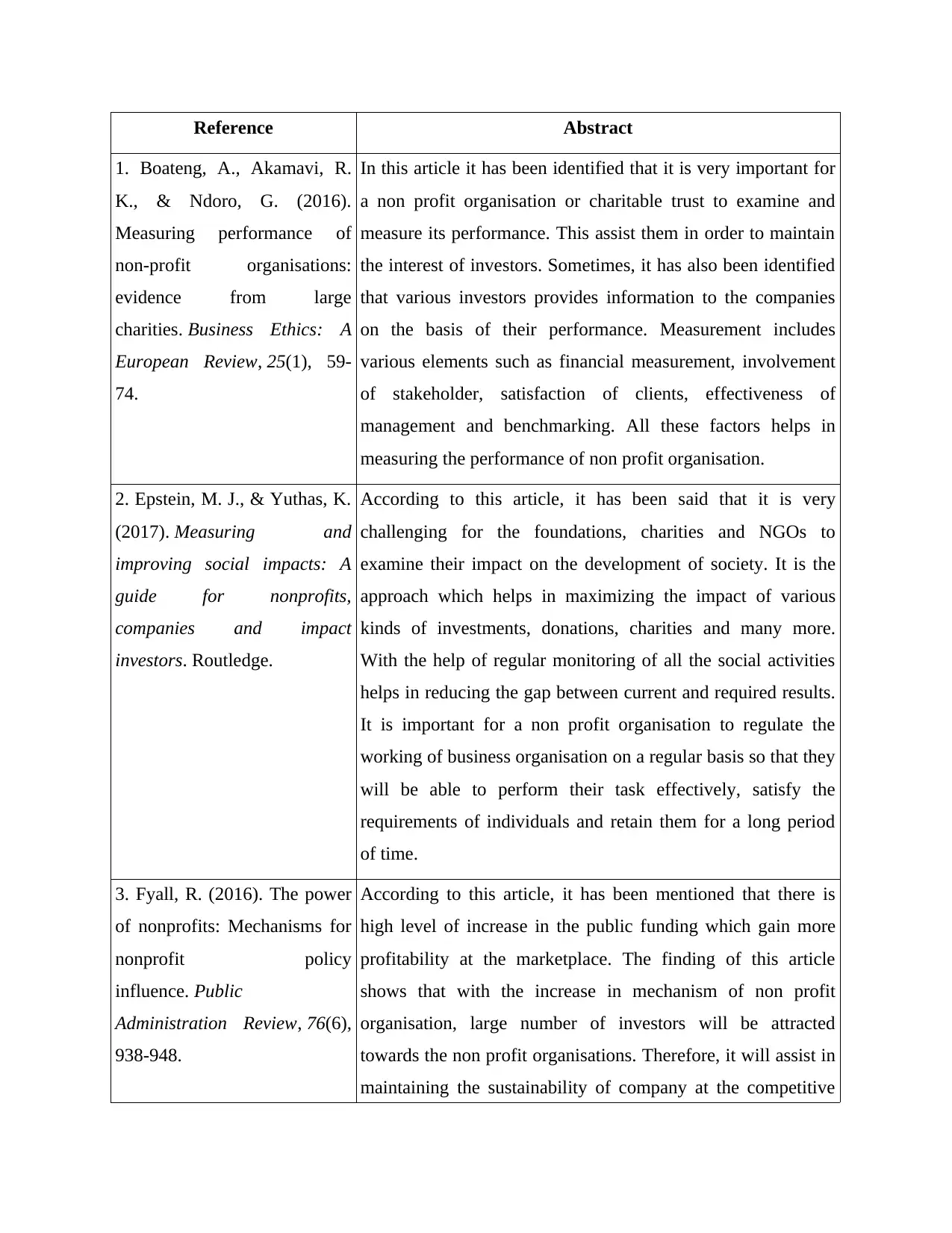
Reference Abstract
1. Boateng, A., Akamavi, R.
K., & Ndoro, G. (2016).
Measuring performance of
non‐profit organisations:
evidence from large
charities. Business Ethics: A
European Review, 25(1), 59-
74.
In this article it has been identified that it is very important for
a non profit organisation or charitable trust to examine and
measure its performance. This assist them in order to maintain
the interest of investors. Sometimes, it has also been identified
that various investors provides information to the companies
on the basis of their performance. Measurement includes
various elements such as financial measurement, involvement
of stakeholder, satisfaction of clients, effectiveness of
management and benchmarking. All these factors helps in
measuring the performance of non profit organisation.
2. Epstein, M. J., & Yuthas, K.
(2017). Measuring and
improving social impacts: A
guide for nonprofits,
companies and impact
investors. Routledge.
According to this article, it has been said that it is very
challenging for the foundations, charities and NGOs to
examine their impact on the development of society. It is the
approach which helps in maximizing the impact of various
kinds of investments, donations, charities and many more.
With the help of regular monitoring of all the social activities
helps in reducing the gap between current and required results.
It is important for a non profit organisation to regulate the
working of business organisation on a regular basis so that they
will be able to perform their task effectively, satisfy the
requirements of individuals and retain them for a long period
of time.
3. Fyall, R. (2016). The power
of nonprofits: Mechanisms for
nonprofit policy
influence. Public
Administration Review, 76(6),
938-948.
According to this article, it has been mentioned that there is
high level of increase in the public funding which gain more
profitability at the marketplace. The finding of this article
shows that with the increase in mechanism of non profit
organisation, large number of investors will be attracted
towards the non profit organisations. Therefore, it will assist in
maintaining the sustainability of company at the competitive
1. Boateng, A., Akamavi, R.
K., & Ndoro, G. (2016).
Measuring performance of
non‐profit organisations:
evidence from large
charities. Business Ethics: A
European Review, 25(1), 59-
74.
In this article it has been identified that it is very important for
a non profit organisation or charitable trust to examine and
measure its performance. This assist them in order to maintain
the interest of investors. Sometimes, it has also been identified
that various investors provides information to the companies
on the basis of their performance. Measurement includes
various elements such as financial measurement, involvement
of stakeholder, satisfaction of clients, effectiveness of
management and benchmarking. All these factors helps in
measuring the performance of non profit organisation.
2. Epstein, M. J., & Yuthas, K.
(2017). Measuring and
improving social impacts: A
guide for nonprofits,
companies and impact
investors. Routledge.
According to this article, it has been said that it is very
challenging for the foundations, charities and NGOs to
examine their impact on the development of society. It is the
approach which helps in maximizing the impact of various
kinds of investments, donations, charities and many more.
With the help of regular monitoring of all the social activities
helps in reducing the gap between current and required results.
It is important for a non profit organisation to regulate the
working of business organisation on a regular basis so that they
will be able to perform their task effectively, satisfy the
requirements of individuals and retain them for a long period
of time.
3. Fyall, R. (2016). The power
of nonprofits: Mechanisms for
nonprofit policy
influence. Public
Administration Review, 76(6),
938-948.
According to this article, it has been mentioned that there is
high level of increase in the public funding which gain more
profitability at the marketplace. The finding of this article
shows that with the increase in mechanism of non profit
organisation, large number of investors will be attracted
towards the non profit organisations. Therefore, it will assist in
maintaining the sustainability of company at the competitive

marketplace which assist them in order to retain their investors
and other stakeholders for a long period of time. With the
assistance of this, it has been concluded that large number of
investors will be able to invest their funds in an effective
manner.
6
and other stakeholders for a long period of time. With the
assistance of this, it has been concluded that large number of
investors will be able to invest their funds in an effective
manner.
6
⊘ This is a preview!⊘
Do you want full access?
Subscribe today to unlock all pages.

Trusted by 1+ million students worldwide
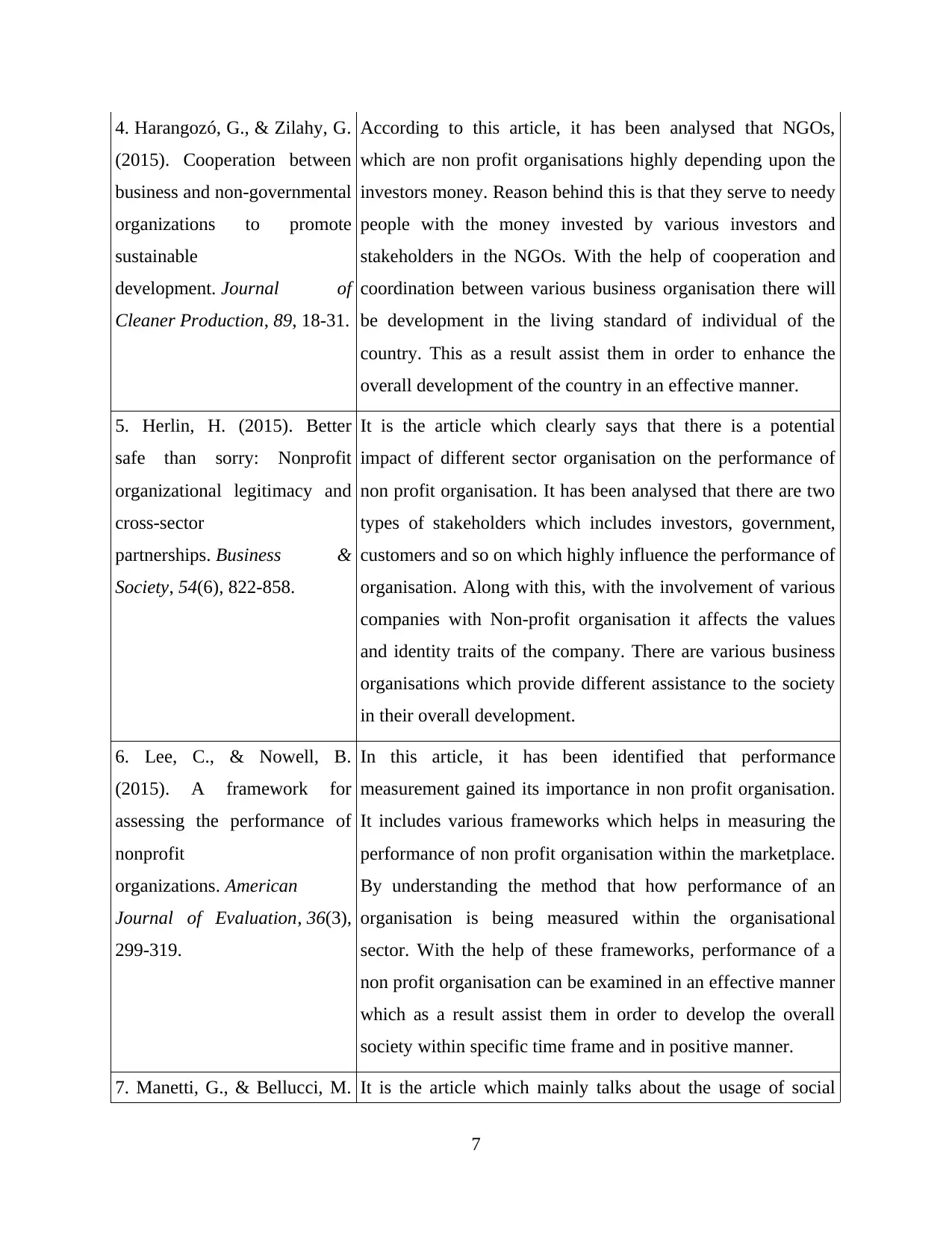
4. Harangozó, G., & Zilahy, G.
(2015). Cooperation between
business and non-governmental
organizations to promote
sustainable
development. Journal of
Cleaner Production, 89, 18-31.
According to this article, it has been analysed that NGOs,
which are non profit organisations highly depending upon the
investors money. Reason behind this is that they serve to needy
people with the money invested by various investors and
stakeholders in the NGOs. With the help of cooperation and
coordination between various business organisation there will
be development in the living standard of individual of the
country. This as a result assist them in order to enhance the
overall development of the country in an effective manner.
5. Herlin, H. (2015). Better
safe than sorry: Nonprofit
organizational legitimacy and
cross-sector
partnerships. Business &
Society, 54(6), 822-858.
It is the article which clearly says that there is a potential
impact of different sector organisation on the performance of
non profit organisation. It has been analysed that there are two
types of stakeholders which includes investors, government,
customers and so on which highly influence the performance of
organisation. Along with this, with the involvement of various
companies with Non-profit organisation it affects the values
and identity traits of the company. There are various business
organisations which provide different assistance to the society
in their overall development.
6. Lee, C., & Nowell, B.
(2015). A framework for
assessing the performance of
nonprofit
organizations. American
Journal of Evaluation, 36(3),
299-319.
In this article, it has been identified that performance
measurement gained its importance in non profit organisation.
It includes various frameworks which helps in measuring the
performance of non profit organisation within the marketplace.
By understanding the method that how performance of an
organisation is being measured within the organisational
sector. With the help of these frameworks, performance of a
non profit organisation can be examined in an effective manner
which as a result assist them in order to develop the overall
society within specific time frame and in positive manner.
7. Manetti, G., & Bellucci, M. It is the article which mainly talks about the usage of social
7
(2015). Cooperation between
business and non-governmental
organizations to promote
sustainable
development. Journal of
Cleaner Production, 89, 18-31.
According to this article, it has been analysed that NGOs,
which are non profit organisations highly depending upon the
investors money. Reason behind this is that they serve to needy
people with the money invested by various investors and
stakeholders in the NGOs. With the help of cooperation and
coordination between various business organisation there will
be development in the living standard of individual of the
country. This as a result assist them in order to enhance the
overall development of the country in an effective manner.
5. Herlin, H. (2015). Better
safe than sorry: Nonprofit
organizational legitimacy and
cross-sector
partnerships. Business &
Society, 54(6), 822-858.
It is the article which clearly says that there is a potential
impact of different sector organisation on the performance of
non profit organisation. It has been analysed that there are two
types of stakeholders which includes investors, government,
customers and so on which highly influence the performance of
organisation. Along with this, with the involvement of various
companies with Non-profit organisation it affects the values
and identity traits of the company. There are various business
organisations which provide different assistance to the society
in their overall development.
6. Lee, C., & Nowell, B.
(2015). A framework for
assessing the performance of
nonprofit
organizations. American
Journal of Evaluation, 36(3),
299-319.
In this article, it has been identified that performance
measurement gained its importance in non profit organisation.
It includes various frameworks which helps in measuring the
performance of non profit organisation within the marketplace.
By understanding the method that how performance of an
organisation is being measured within the organisational
sector. With the help of these frameworks, performance of a
non profit organisation can be examined in an effective manner
which as a result assist them in order to develop the overall
society within specific time frame and in positive manner.
7. Manetti, G., & Bellucci, M. It is the article which mainly talks about the usage of social
7
Paraphrase This Document
Need a fresh take? Get an instant paraphrase of this document with our AI Paraphraser
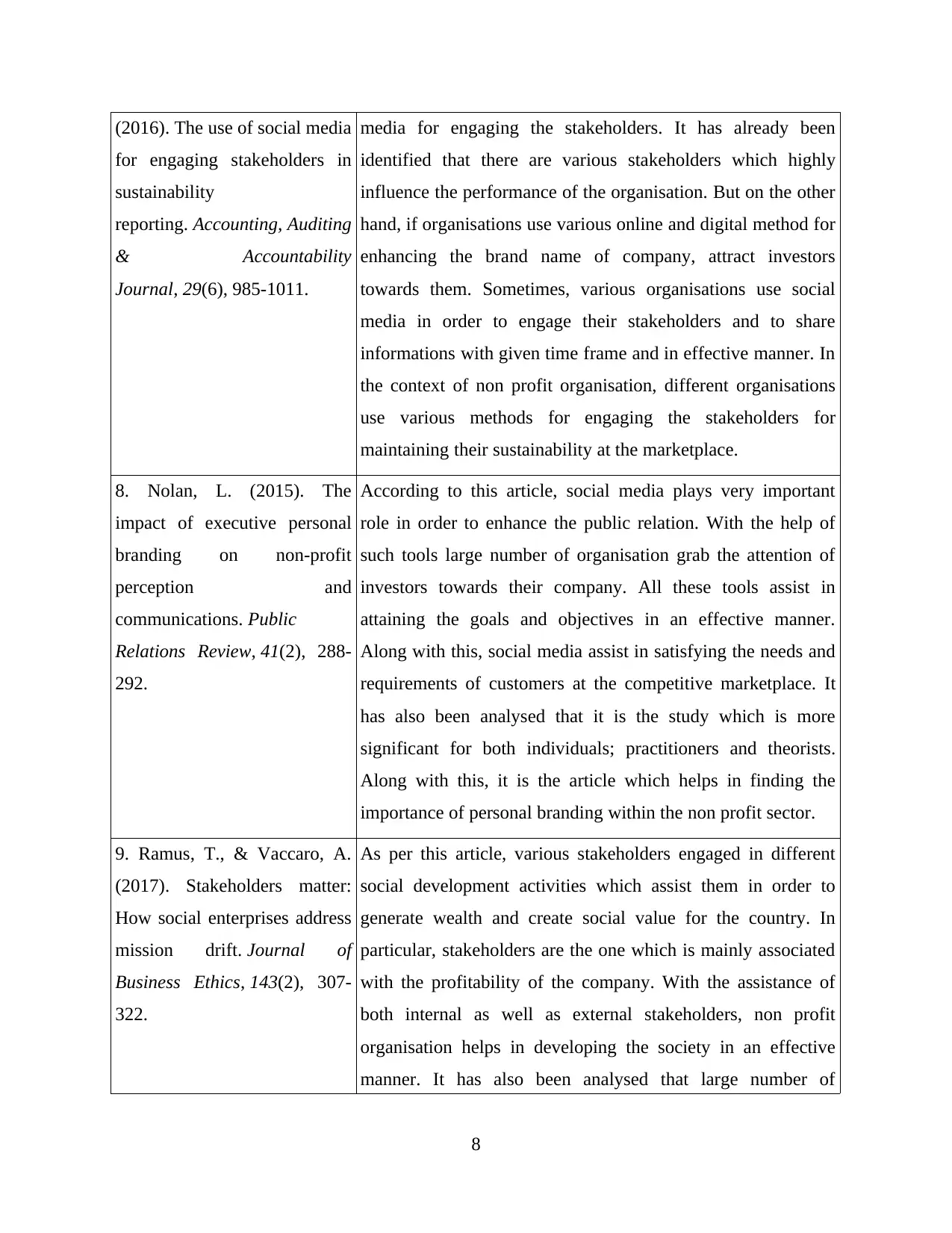
(2016). The use of social media
for engaging stakeholders in
sustainability
reporting. Accounting, Auditing
& Accountability
Journal, 29(6), 985-1011.
media for engaging the stakeholders. It has already been
identified that there are various stakeholders which highly
influence the performance of the organisation. But on the other
hand, if organisations use various online and digital method for
enhancing the brand name of company, attract investors
towards them. Sometimes, various organisations use social
media in order to engage their stakeholders and to share
informations with given time frame and in effective manner. In
the context of non profit organisation, different organisations
use various methods for engaging the stakeholders for
maintaining their sustainability at the marketplace.
8. Nolan, L. (2015). The
impact of executive personal
branding on non-profit
perception and
communications. Public
Relations Review, 41(2), 288-
292.
According to this article, social media plays very important
role in order to enhance the public relation. With the help of
such tools large number of organisation grab the attention of
investors towards their company. All these tools assist in
attaining the goals and objectives in an effective manner.
Along with this, social media assist in satisfying the needs and
requirements of customers at the competitive marketplace. It
has also been analysed that it is the study which is more
significant for both individuals; practitioners and theorists.
Along with this, it is the article which helps in finding the
importance of personal branding within the non profit sector.
9. Ramus, T., & Vaccaro, A.
(2017). Stakeholders matter:
How social enterprises address
mission drift. Journal of
Business Ethics, 143(2), 307-
322.
As per this article, various stakeholders engaged in different
social development activities which assist them in order to
generate wealth and create social value for the country. In
particular, stakeholders are the one which is mainly associated
with the profitability of the company. With the assistance of
both internal as well as external stakeholders, non profit
organisation helps in developing the society in an effective
manner. It has also been analysed that large number of
8
for engaging stakeholders in
sustainability
reporting. Accounting, Auditing
& Accountability
Journal, 29(6), 985-1011.
media for engaging the stakeholders. It has already been
identified that there are various stakeholders which highly
influence the performance of the organisation. But on the other
hand, if organisations use various online and digital method for
enhancing the brand name of company, attract investors
towards them. Sometimes, various organisations use social
media in order to engage their stakeholders and to share
informations with given time frame and in effective manner. In
the context of non profit organisation, different organisations
use various methods for engaging the stakeholders for
maintaining their sustainability at the marketplace.
8. Nolan, L. (2015). The
impact of executive personal
branding on non-profit
perception and
communications. Public
Relations Review, 41(2), 288-
292.
According to this article, social media plays very important
role in order to enhance the public relation. With the help of
such tools large number of organisation grab the attention of
investors towards their company. All these tools assist in
attaining the goals and objectives in an effective manner.
Along with this, social media assist in satisfying the needs and
requirements of customers at the competitive marketplace. It
has also been analysed that it is the study which is more
significant for both individuals; practitioners and theorists.
Along with this, it is the article which helps in finding the
importance of personal branding within the non profit sector.
9. Ramus, T., & Vaccaro, A.
(2017). Stakeholders matter:
How social enterprises address
mission drift. Journal of
Business Ethics, 143(2), 307-
322.
As per this article, various stakeholders engaged in different
social development activities which assist them in order to
generate wealth and create social value for the country. In
particular, stakeholders are the one which is mainly associated
with the profitability of the company. With the assistance of
both internal as well as external stakeholders, non profit
organisation helps in developing the society in an effective
manner. It has also been analysed that large number of
8
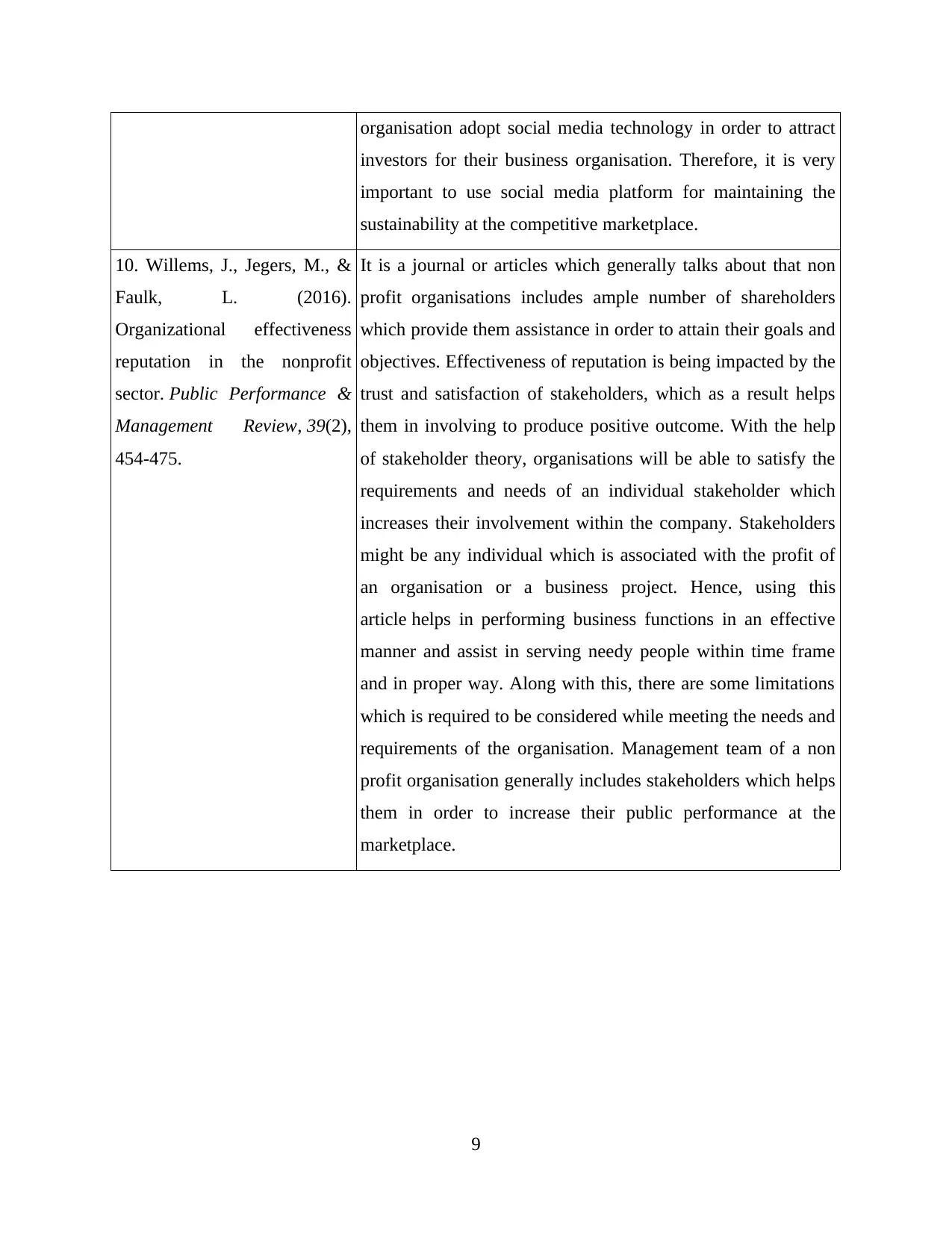
organisation adopt social media technology in order to attract
investors for their business organisation. Therefore, it is very
important to use social media platform for maintaining the
sustainability at the competitive marketplace.
10. Willems, J., Jegers, M., &
Faulk, L. (2016).
Organizational effectiveness
reputation in the nonprofit
sector. Public Performance &
Management Review, 39(2),
454-475.
It is a journal or articles which generally talks about that non
profit organisations includes ample number of shareholders
which provide them assistance in order to attain their goals and
objectives. Effectiveness of reputation is being impacted by the
trust and satisfaction of stakeholders, which as a result helps
them in involving to produce positive outcome. With the help
of stakeholder theory, organisations will be able to satisfy the
requirements and needs of an individual stakeholder which
increases their involvement within the company. Stakeholders
might be any individual which is associated with the profit of
an organisation or a business project. Hence, using this
article helps in performing business functions in an effective
manner and assist in serving needy people within time frame
and in proper way. Along with this, there are some limitations
which is required to be considered while meeting the needs and
requirements of the organisation. Management team of a non
profit organisation generally includes stakeholders which helps
them in order to increase their public performance at the
marketplace.
9
investors for their business organisation. Therefore, it is very
important to use social media platform for maintaining the
sustainability at the competitive marketplace.
10. Willems, J., Jegers, M., &
Faulk, L. (2016).
Organizational effectiveness
reputation in the nonprofit
sector. Public Performance &
Management Review, 39(2),
454-475.
It is a journal or articles which generally talks about that non
profit organisations includes ample number of shareholders
which provide them assistance in order to attain their goals and
objectives. Effectiveness of reputation is being impacted by the
trust and satisfaction of stakeholders, which as a result helps
them in involving to produce positive outcome. With the help
of stakeholder theory, organisations will be able to satisfy the
requirements and needs of an individual stakeholder which
increases their involvement within the company. Stakeholders
might be any individual which is associated with the profit of
an organisation or a business project. Hence, using this
article helps in performing business functions in an effective
manner and assist in serving needy people within time frame
and in proper way. Along with this, there are some limitations
which is required to be considered while meeting the needs and
requirements of the organisation. Management team of a non
profit organisation generally includes stakeholders which helps
them in order to increase their public performance at the
marketplace.
9
⊘ This is a preview!⊘
Do you want full access?
Subscribe today to unlock all pages.

Trusted by 1+ million students worldwide
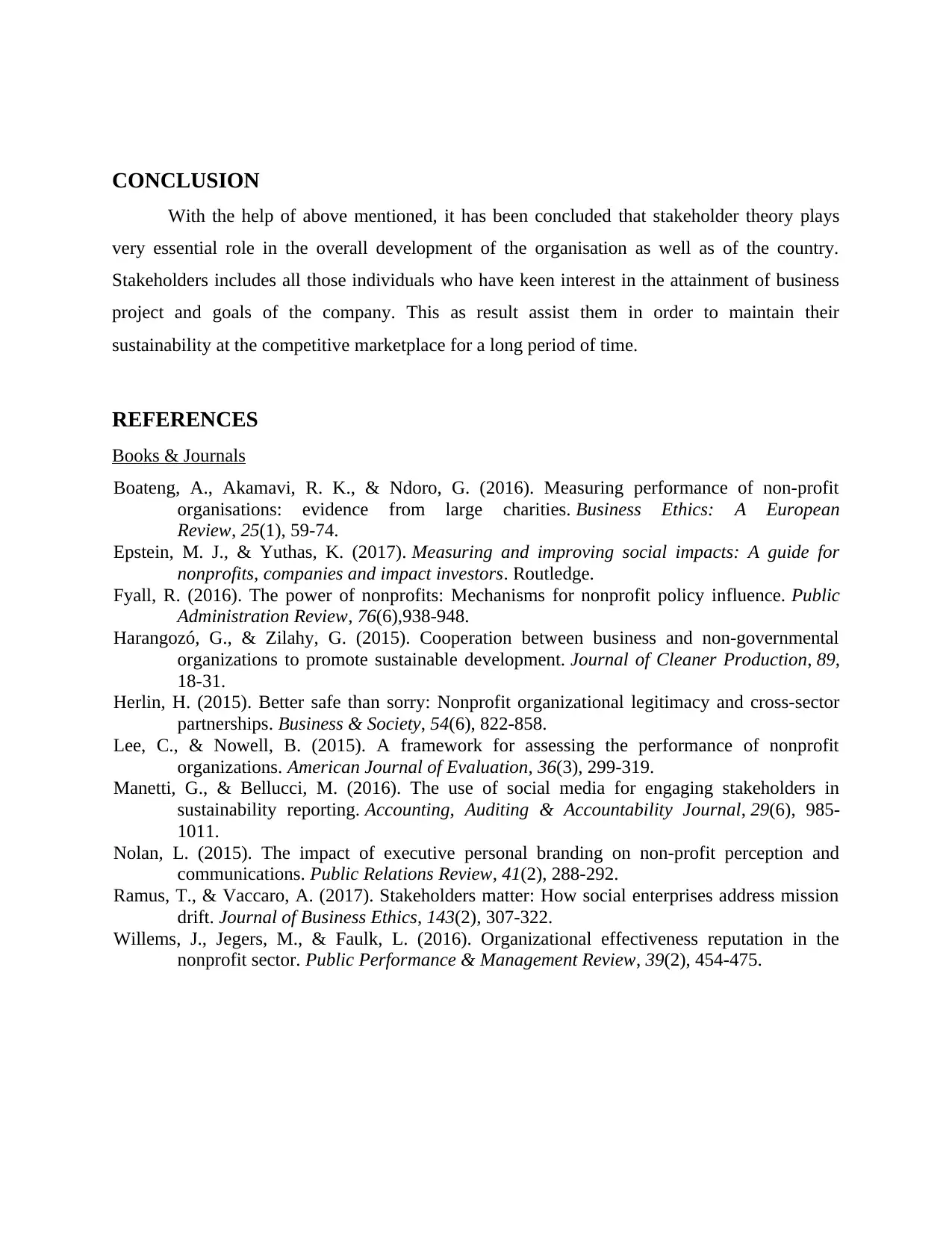
CONCLUSION
With the help of above mentioned, it has been concluded that stakeholder theory plays
very essential role in the overall development of the organisation as well as of the country.
Stakeholders includes all those individuals who have keen interest in the attainment of business
project and goals of the company. This as result assist them in order to maintain their
sustainability at the competitive marketplace for a long period of time.
REFERENCES
Books & Journals
Boateng, A., Akamavi, R. K., & Ndoro, G. (2016). Measuring performance of non‐profit
organisations: evidence from large charities. Business Ethics: A European
Review, 25(1), 59-74.
Epstein, M. J., & Yuthas, K. (2017). Measuring and improving social impacts: A guide for
nonprofits, companies and impact investors. Routledge.
Fyall, R. (2016). The power of nonprofits: Mechanisms for nonprofit policy influence. Public
Administration Review, 76(6),938-948.
Harangozó, G., & Zilahy, G. (2015). Cooperation between business and non-governmental
organizations to promote sustainable development. Journal of Cleaner Production, 89,
18-31.
Herlin, H. (2015). Better safe than sorry: Nonprofit organizational legitimacy and cross-sector
partnerships. Business & Society, 54(6), 822-858.
Lee, C., & Nowell, B. (2015). A framework for assessing the performance of nonprofit
organizations. American Journal of Evaluation, 36(3), 299-319.
Manetti, G., & Bellucci, M. (2016). The use of social media for engaging stakeholders in
sustainability reporting. Accounting, Auditing & Accountability Journal, 29(6), 985-
1011.
Nolan, L. (2015). The impact of executive personal branding on non-profit perception and
communications. Public Relations Review, 41(2), 288-292.
Ramus, T., & Vaccaro, A. (2017). Stakeholders matter: How social enterprises address mission
drift. Journal of Business Ethics, 143(2), 307-322.
Willems, J., Jegers, M., & Faulk, L. (2016). Organizational effectiveness reputation in the
nonprofit sector. Public Performance & Management Review, 39(2), 454-475.
With the help of above mentioned, it has been concluded that stakeholder theory plays
very essential role in the overall development of the organisation as well as of the country.
Stakeholders includes all those individuals who have keen interest in the attainment of business
project and goals of the company. This as result assist them in order to maintain their
sustainability at the competitive marketplace for a long period of time.
REFERENCES
Books & Journals
Boateng, A., Akamavi, R. K., & Ndoro, G. (2016). Measuring performance of non‐profit
organisations: evidence from large charities. Business Ethics: A European
Review, 25(1), 59-74.
Epstein, M. J., & Yuthas, K. (2017). Measuring and improving social impacts: A guide for
nonprofits, companies and impact investors. Routledge.
Fyall, R. (2016). The power of nonprofits: Mechanisms for nonprofit policy influence. Public
Administration Review, 76(6),938-948.
Harangozó, G., & Zilahy, G. (2015). Cooperation between business and non-governmental
organizations to promote sustainable development. Journal of Cleaner Production, 89,
18-31.
Herlin, H. (2015). Better safe than sorry: Nonprofit organizational legitimacy and cross-sector
partnerships. Business & Society, 54(6), 822-858.
Lee, C., & Nowell, B. (2015). A framework for assessing the performance of nonprofit
organizations. American Journal of Evaluation, 36(3), 299-319.
Manetti, G., & Bellucci, M. (2016). The use of social media for engaging stakeholders in
sustainability reporting. Accounting, Auditing & Accountability Journal, 29(6), 985-
1011.
Nolan, L. (2015). The impact of executive personal branding on non-profit perception and
communications. Public Relations Review, 41(2), 288-292.
Ramus, T., & Vaccaro, A. (2017). Stakeholders matter: How social enterprises address mission
drift. Journal of Business Ethics, 143(2), 307-322.
Willems, J., Jegers, M., & Faulk, L. (2016). Organizational effectiveness reputation in the
nonprofit sector. Public Performance & Management Review, 39(2), 454-475.
Paraphrase This Document
Need a fresh take? Get an instant paraphrase of this document with our AI Paraphraser

11
1 out of 11
Related Documents
Your All-in-One AI-Powered Toolkit for Academic Success.
+13062052269
info@desklib.com
Available 24*7 on WhatsApp / Email
![[object Object]](/_next/static/media/star-bottom.7253800d.svg)
Unlock your academic potential
Copyright © 2020–2025 A2Z Services. All Rights Reserved. Developed and managed by ZUCOL.





